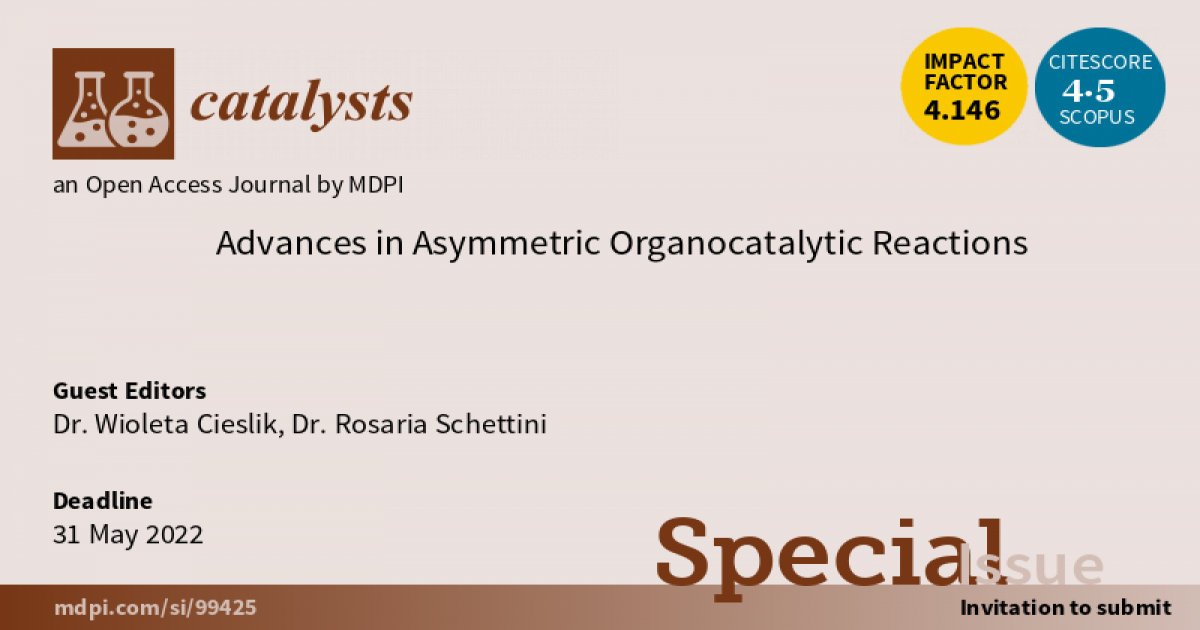Advances in Asymmetric Organocatalytic Reactions
A special issue of Catalysts (ISSN 2073-4344). This special issue belongs to the section "Catalysis in Organic and Polymer Chemistry".
Deadline for manuscript submissions: closed (30 November 2022) | Viewed by 10204

Special Issue Editors
Interests: organocatalysis; asymmetric synthesis; cycloaddition; nanomaterials; anticancer activity; kinase inhibition; antifungal activity
Interests: synthesis of cyclic peptoids and their derivatives; phase-transfer catalysts; asymmetric synthesis; macrocyclic catalysts
Special Issues, Collections and Topics in MDPI journals
Special Issue Information
Dear Colleagues,
Asymmetric organocatalysis has recently experienced impressive growth and is considered to be an independent set of synthetic tools for the preparation of chiral organic molecules. Due to the numerous advantages of organocatalysis, including high efficiency and stereoselectivity of reactions, it has quickly found applications in synthetic, medicinal, and materials chemistry.
Organocatalysts are metal free, non-toxic, and environmentally benign. In addition, they are durable compounds and many of them are commercially available or are easily synthesized. They are usually stable under aerobic conditions and their reactions do not require extremely dry conditions. Frequently, their reactions are carried out under mild conditions and at high concentrations, thereby avoiding the use of large amounts of solvents and minimizing the amount of waste. In addition to these features, organocatalysts are tolerant of many functional groups and thus do not require any time-consuming manipulation of protective groups.
This Special Issue will provide a contemporary overview of progress in the broad field of asymmetric organocatalysis. Topics include the design and synthesis of organocatalysts, the development of new catalytic systems, applications of organocatalysts in asymmetric synthesis, mechanistic studies, and synthetic applications in the preparation of chiral products important in the pharmaceutical or material sciences. Full papers, communications, and mini-reviews are welcome in this issue.
Dr. Wioleta Cieslik
Dr. Rosaria Schettini
Guest Editors
Manuscript Submission Information
Manuscripts should be submitted online at www.mdpi.com by registering and logging in to this website. Once you are registered, click here to go to the submission form. Manuscripts can be submitted until the deadline. All submissions that pass pre-check are peer-reviewed. Accepted papers will be published continuously in the journal (as soon as accepted) and will be listed together on the special issue website. Research articles, review articles as well as short communications are invited. For planned papers, a title and short abstract (about 100 words) can be sent to the Editorial Office for announcement on this website.
Submitted manuscripts should not have been published previously, nor be under consideration for publication elsewhere (except conference proceedings papers). All manuscripts are thoroughly refereed through a single-blind peer-review process. A guide for authors and other relevant information for submission of manuscripts is available on the Instructions for Authors page. Catalysts is an international peer-reviewed open access monthly journal published by MDPI.
Please visit the Instructions for Authors page before submitting a manuscript. The Article Processing Charge (APC) for publication in this open access journal is 2200 CHF (Swiss Francs). Submitted papers should be well formatted and use good English. Authors may use MDPI's English editing service prior to publication or during author revisions.
Keywords
- organocatalysis
- asymmetric synthesis
- enantioselectivity
- diastereoisomers
- enantiomers
- bifunctional catalysis
- catalyst immobilization
- nonmetal catalysis
- photocatalysis
- chirality
Benefits of Publishing in a Special Issue
- Ease of navigation: Grouping papers by topic helps scholars navigate broad scope journals more efficiently.
- Greater discoverability: Special Issues support the reach and impact of scientific research. Articles in Special Issues are more discoverable and cited more frequently.
- Expansion of research network: Special Issues facilitate connections among authors, fostering scientific collaborations.
- External promotion: Articles in Special Issues are often promoted through the journal's social media, increasing their visibility.
- e-Book format: Special Issues with more than 10 articles can be published as dedicated e-books, ensuring wide and rapid dissemination.
Further information on MDPI's Special Issue polices can be found here.






